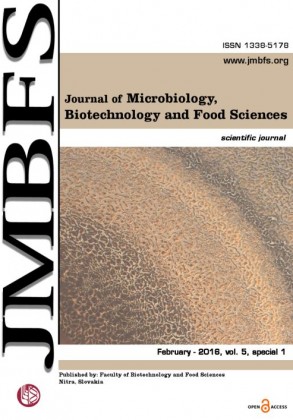IN VITRO EFFECT OF 4-NONYLPHENOL ON cAMP STIMULATED ANDROSTENEDIONE PRODUCTION AND VIABILITY OF MICE LEYDIG CELLS
DOI:
https://doi.org/10.15414/jmbfs.2016.5.special1.14-16Keywords:
Leydig cells, nonylphenol, androstenedione, viabilityAbstract
The toxic effect of various environmental contaminants such as heavy metals or industrial chemicals such as alkylphenolson male reproductive systemwasfound. 4-nonylphenol (4-NP), one of the environmental contaminants used in the manufacture of plastics and other products, is released largely into the environment. The majority of studies on NP have focused on their endocrine disrupting and potential adverse effects on reproductive system. The target of our in vitro study was to determine the potential impact of 4–nonylphenol as an endocrine disruptor on the hormonal secretion and viability of mice Leydig cells. Cells were cultured with addition of 0.04; 0.2; 1.0; 2.5; and 5.0 µg/mL of 4–nonylphenol for 44h and compared with the control. Cells destined for the determination of androstenedione production were cultured in the presence of cyclic AMP solution. Quantification of cAMP stimulated androstenedion production directly from aliquots of the medium was performed by enzyme linked immunosorbent assay (ELISA). The viability of Leydig cells was detected by the metabolic activity (MTT) assay. The cAMP stimulated androstenedione production significantly (P<0.05) decreased at 2.5 and 5.0 µg/mL of 4-nonylphenol concentration. The viability of mice Leydig cells was decreased at the doses of 0.2; 1.0; 2.5 and 5.0 µg/mL of 4-nonylphenol, but this decrease was not significant. Further investigations are essential to clarify the mechanism of action of endocrine disruptor on male mice, as well as to establish the biological significance of the observed phenomena.Downloads
Download data is not yet available.
Downloads
Published
2016-02-08
How to Cite
Jambor, T., LukáÄová, J., Tvrdá, E., Forgács, Z., & LukáÄ, N. (2016). IN VITRO EFFECT OF 4-NONYLPHENOL ON cAMP STIMULATED ANDROSTENEDIONE PRODUCTION AND VIABILITY OF MICE LEYDIG CELLS. Journal of Microbiology, Biotechnology and Food Sciences, 5(special 1), 14–16. https://doi.org/10.15414/jmbfs.2016.5.special1.14-16
Issue
Section
Biotechnology
License
Copyright (c) 2016 Tomáš Jambor, Jana LukáÄová, Eva Tvrdá, Zsolt Forgács, Norbert LukáÄ

This work is licensed under a Creative Commons Attribution 4.0 International License.
All papers published in the Journal of Microbiology, Biotechnology and Food Sciences are published under a CC-BY licence (CC-BY 4.0). Published materials can be shared (copy and redistribute the material in any medium or format) and adapted (remix, transform, and build upon the material for any purpose, even commercially) with specifying the author(s).





